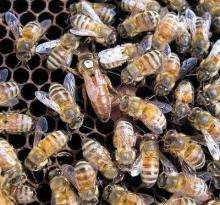April 27, 2011 report
Secret of royal jelly's super-sizing effect on queen bees appears to be special protein royalactin

(PhysOrg.com) -- In a paper published in Nature, Japanese researcher Masaki Kamakura describes a process he used to determine that the protein royalactin, is at least one of the components responsible for turning an ordinary female bee, into a queen. In a simple process of elimination experiment, Kamakura, was able to separate the different substances that comprise royal jelly, which then allowed him to feed those substances individually to a female bee to see which caused her to take on queen bee traits.
In the simple but brilliant experiment, the individual components that make up royal jelly were obtained by allowing the jelly to decompose under different temperatures. Since the components decomposed at differing rates, Kamakura was able to separate them at each stage, which then allowed him to whip up a diet comprised of just the individual substance (mixed with other nutrients) that he fed to his test female bees, until he came upon the one that finally did the trick.
To prove his point, Kamakura also fed the royalactin mix to female fruit flies, a rather close cousin on the genetic tree, and discovered it caused queen bee like effects on them as well. They grew larger than normal, became better procreators and lived longer.
A thick white milky solution, royal jelly is excreted by female nurse bees, who deposit it for the queen to eat, and that’s all she eats, which is a good thing for her, since it causes her to grow larger, weigh more, and perhaps more importantly, to live far longer than anyone else in the hive. Because of its so-called magical properties, royal jelly has also been used by us humans for thousands of years for a variety of reasons, and while some claim it can help slow the effects of aging on skin, there is no evidence to suggest it can cause people to grow larger, live longer or produce more offspring.
It’s thought that royal jelly, and now just perhaps royalactin, are able to cause such changes in bees because it is a substance that is “recognized” by a protein called EGFR which is already existent in the bees chemistry and is known to be able to sense epidermal growth factor hormones. How it all works is still a mystery however, and because of that, there is still much research left to do before all of the secrets of royal jelly are finally revealed.
More information: Royalactin induces queen differentiation in honeybees, Nature (2011) doi:10.1038/nature10093
Abstract
The honeybee (Apis mellifera) forms two female castes: the queen and the worker. This dimorphism depends not on genetic differences, but on ingestion of royal jelly, although the mechanism through which royal jelly regulates caste differentiation has long remained unknown. Here I show that a 57-kDa protein in royal jelly, previously designated as royalactin, induces the differentiation of honeybee larvae into queens. Royalactin increased body size and ovary development and shortened developmental time in honeybees. Surprisingly, it also showed similar effects in the fruitfly (Drosophila melanogaster). Mechanistic studies revealed that royalactin activated p70 S6 kinase, which was responsible for the increase of body size, increased the activity of mitogen-activated protein kinase, which was involved in the decreased developmental time, and increased the titre of juvenile hormone, an essential hormone for ovary development. Knockdown of epidermal growth factor receptor (Egfr) expression in the fat body of honeybees and fruitflies resulted in a defect of all phenotypes induced by royalactin, showing that Egfr mediates these actions. These findings indicate that a specific factor in royal jelly, royalactin, drives queen development through an Egfr-mediated signalling pathway.
© 2010 PhysOrg.com

















